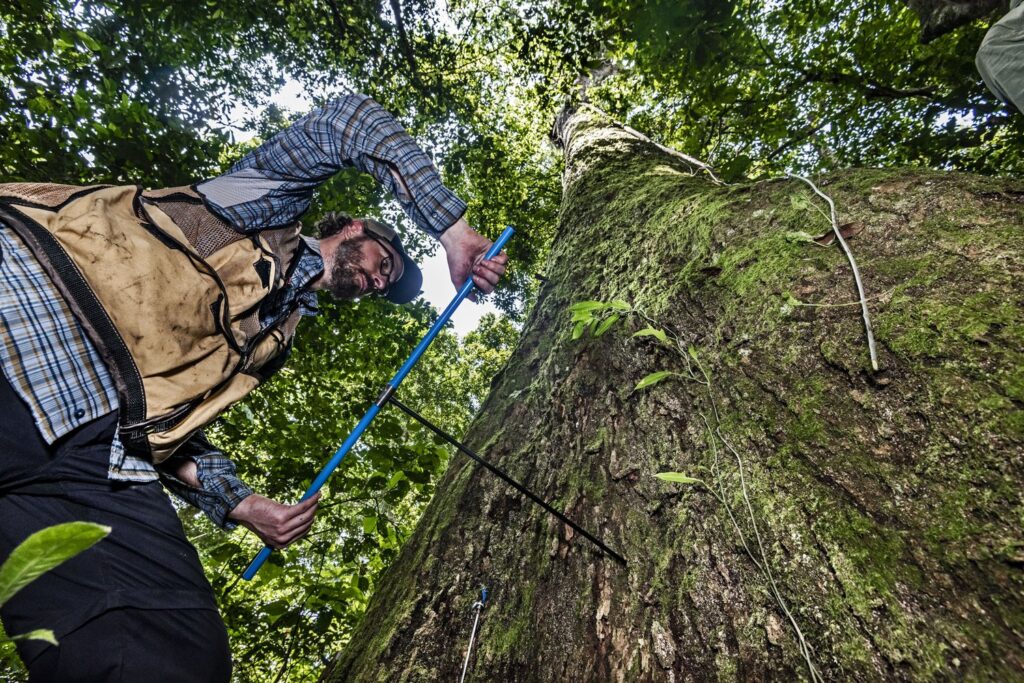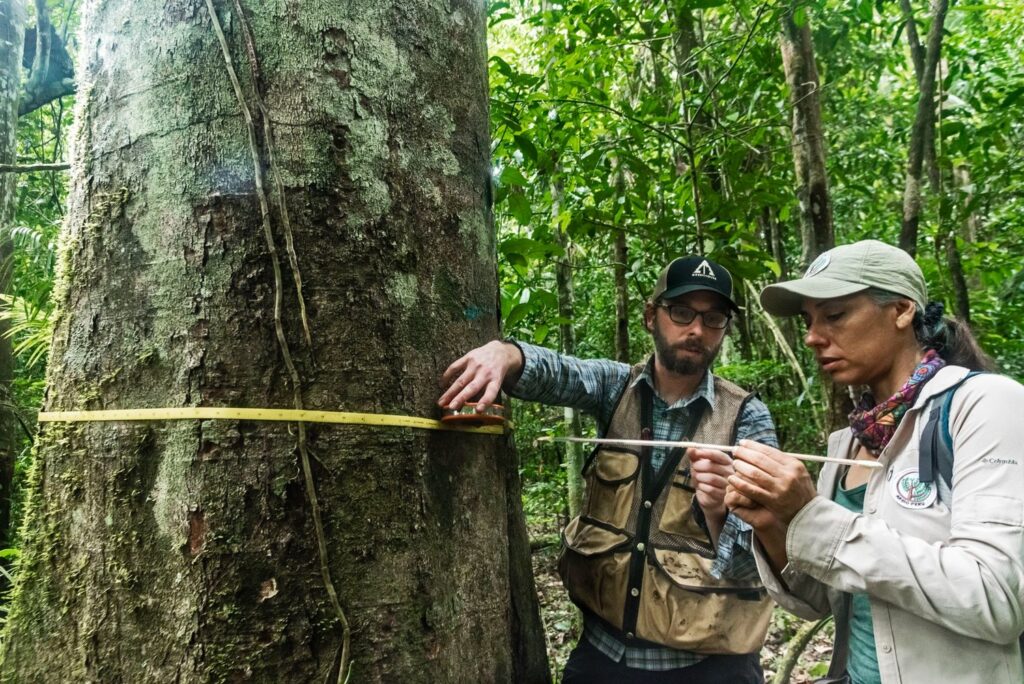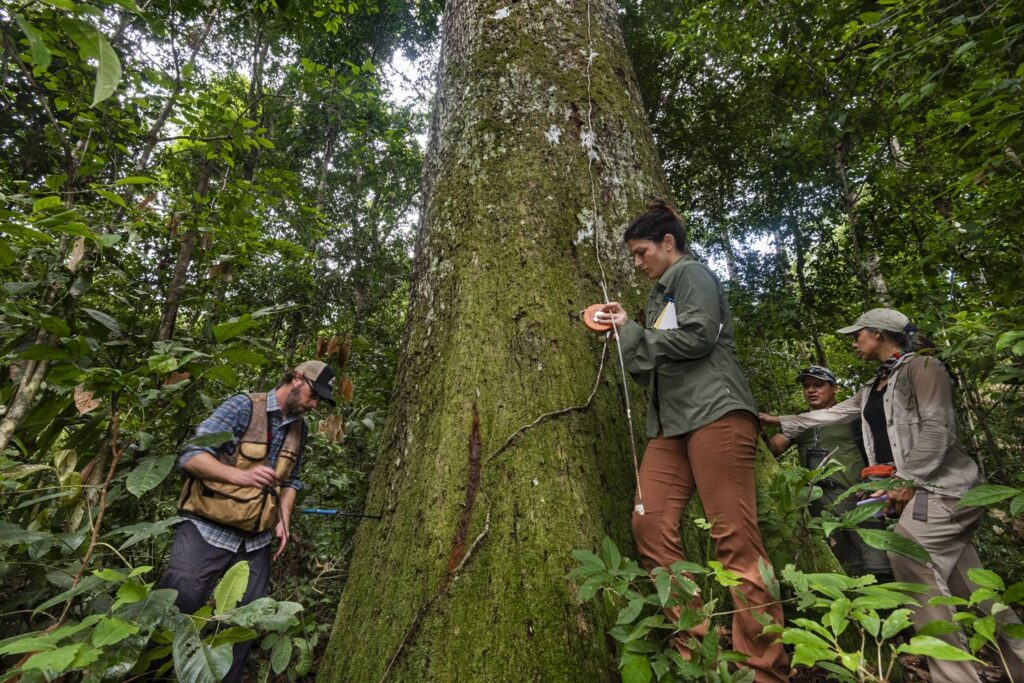Articulo original:
https://ravelagency.com/blog/2022/1/19/an-interview-with-dendrochronologist-stockton-maxwell
Escrito por: Susuna Lay / Fotos: Michael Tweddle
During his last visit to the Amazon Rainforest, dendrochronologist Stockton Maxwell —of the Radford University Tree Ring Laboratory (Virginia, US)— had a chance to core a Brazil nut tree in hopes of learning more about past climate sequences in the Las Piedras region of Peru’s Madre de Dios. We were there to witness the “treeringist” in action and talked to him about the fantastic science of tree-ring dating and what it can reveal about past environmental and climate changes.

Photo: Michael Tweddle
Can you tell us about yourself and how you came to be a dendrochronologist?
My path to dendrochronology is a bit winding. I studied behavioral psychology as an undergraduate conducting research with rats and pigeons. After graduation, I worked as a research assistant in the Department of Psychiatry at Temple University in Philadelphia, Pennsylvania. It was an interesting job and I worked with some great people but I had an office without windows and lacked the passion that my co-workers had. After hiking in the White Mountains in New Hampshire one weekend, I decided that I wanted a job that focused on the environment. I went to graduate school for forestry the next year and knew I was going in the right direction. For my Master’s Thesis Project, I wanted to learn dendrochronology to study past wildfire frequency in the New River Gorge National Park, West Virginia. My master’s advisor recommended that I attend the North American Dendroecological Fieldweek, a professional training workshop on tree-ring analysis that I now help co-organize and instruct. After the workshop, I was hooked! I enjoyed the hands-on nature of the research and how it could be applied across a variety of questions from how trees respond to changes in climate, how wildfires behaved in the past, how insect outbreaks affect the forest, and on and on.
As my forestry studies progressed, I also began to take courses in geography where I met my PhD advisor. She is a dendrochronologist too and she recruited me to work in her lab. My dissertation in geography focused on climate reconstructions in the mid-Atlantic region of the eastern US. Now, as a professor and scientist, dendrochronology is my primary research field. I am active in my field through publishing scientific papers but I also instruct and co-organize the annual workshop. Most recently, I instructed a dendrochronology workshop in Zambia.
How do you use tree rings to reveal information?
Dendrochronology has a wide range of applications from archaeology to climate reconstruction, to calibrating radiocarbon dates and dating past wildfire events. My research focuses on learning about past environmental and climate changes by examining the patterns of narrow and wide annual rings, injuries to tree rings, and carbon isotopes stored in wood. In the reconstruction of climate using tree rings, annual ring widths indicate what the climate was like in a particular year in the past.
For example, in the mid-latitude regions of the world, wide rings often indicate wet periods in the past while narrow rings indicate drought. Understanding the past changes in precipitation can help scientists quantify how rainfall has changed over decades to centuries and determine if the changes we see now in climate are out of the ordinary. Tree rings can be used to reconstruct past volume of water flowing in rivers, mountain snowpack, temperature, lake levels, and similar climatic variables. In addition to climate reconstruction, some of my research focuses on how trees change growth responses when climate changes. For example, as the atmosphere warms, will trees become more drought-stressed? How might this affect a tree species ability to adapt to climate change?
For other projects, I have used changes in growth rates and injuries to trees to date past forest disturbances like low-severity wildfires, storm events, insect outbreaks, and changes in land-use history.
Finally, I have used carbon isotope concentrations in annual tree rings to model how trees change growth strategies as carbon dioxide concentrations in the atmosphere increase. By understanding the growth strategy of trees in response to anthropogenic carbon dioxide, we can better understand how forests will store carbon and potentially mitigate human-caused warming.

Foto: Michael Tweddle
We had a chance to look at the process of obtaining tree core samples of a Brazil-nut tree in the Amazon Rainforest. What kind of information interests you about this tree species?
The Brazil nut tree is a charismatic species. It is a towering giant in the rainforests that can live for centuries. I choose to study Brazil nut because it is known to form annual rings and it is sensitive to changes in precipitation. By studying the species, I hope to learn about past climate in the Las Piedras region and hopefully build a reconstruction of past moisture. This is critically important because we have little data about past climate in the tropics. Additionally, there are some basic questions yet to be answered about Brazil nut trees growing in the Madre de Dios region. How fast does the species grow each year? What is the maximum and mean tree ages? Do trees establish in cohorts or individually over time? How does annual growth increment correlate to nut production? Do trees rapidly ascend to the canopy or do they stay in the understory for a period of time? How can indigenous knowledge help us interpret the tree-ring record? How can the tree-ring chronology of Brazil nut help us understand past land use? So many questions!
Do you think living trees in the tropical rainforest can unravel the impacts of climate change? How about past human societies and their relationship with the forest?
Reconstructions of drought and precipitation from tree rings have been conducted for most regions of the world except for the tropical regions where trees may not form annual rings. This has halted efforts to learn about past climate over the past centuries or longer. However, more research is now being conducted as dendrochronologists in these regions are being trained. I hypothesize that the annual growth rings of Brazil nut will hold information about past changes in precipitation and help us learn how the present trends compare to the past centuries. Additionally, I plan to study how the growth response to precipitation and temperature might have changed as the climate of the past decades has changed. Will trees remain resilient to variability in temperature and precipitation? Or will trees become more vulnerable as their ideal climate shifts north or south? This information will be needed to better manage rainforest ecosystems.
Gaining insights into past human civilization from dendrochronology in the tropics is difficult because there are few historical accounts of settlement to compare to ring widths. However, I may be able to establish if trees began to establish in cohorts versus individually. If trees established in cohorts, it might indicate that larger-scale forest disturbances were present in the past that opened larger areas of forests. Large forest openings can occur naturally from wind storms, wildfire, and movement of the river; however, large openings might also be caused by land clearing from humans. If trees establish more randomly, that would indicate the Brazil nut trees established in smaller gaps. Smaller gaps would likely be naturally caused by tree fall. I’m not sure if humans would create small gaps to grow nut trees.
Can certain markers help researchers to recognize past events of large-scale forest clearance and land degradation?
Probably the best indicator of large-scale disturbance would be uniform cohorts of tree establishment across a landscape. But without some other evidence of settlement tree establishment dates would be speculative. The tree-ring data would be a better indicator of land clearing in areas that were more recently cleared and have regrown into the forest. Remote sensing data of forests might also be used to detect landscape-scale changes to the forest in more recent decades.

Photo: Michael Tweddle
What are some of your favorite discoveries of dendrochronology in the Peruvian Amazon rainforest so far?
I have only had the opportunity to collect tree-ring samples from a few species in the rainforest but I’m most surprised by the diversity of species and the number of species that form annual rings. Typically for an annual ring to form a tree must shut down wood growth for a period of time. In the rainforest, this is would be caused by the transition from the wet to dry season. While there is still ample precipitation for some plant species to thrive, it appears that some tree species cease wood growth.
Coring Brazil nut trees was a unique experience. I have not encountered so many trees in one area that have stored large quantities of methane as I showed you in the video. It makes me think that the diversity of the rainforest ecosystem does not stop on the outside of the tree but that bacteria, fungi, and virus make their homes inside trees as well. The methane build-up is a bi-product of microbial decay inside the tree. I wonder if the methane build-up is unique to Brazil nut or common across the forest.
The “bleeding” red sap coming from inside the trees was probably the craziest thing I have seen when coring trees. It oozed like thick blood. Again, the red sap is probably another bi-product of decay or fermentation in the tree. The sap underneath the bark had a similar consistency but was white or cream-colored rather than red. The sap is an adaptation to protect the tree from insects and help block external injuries from invasion. I wonder if this sap has any medicinal purposes. Paul Rosolie and I collected a sample to provide to his colleague for analysis.